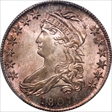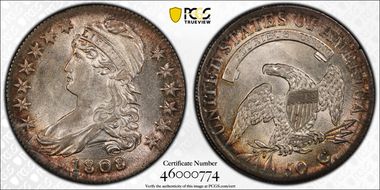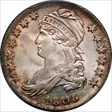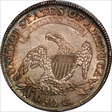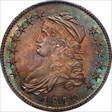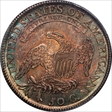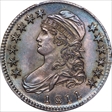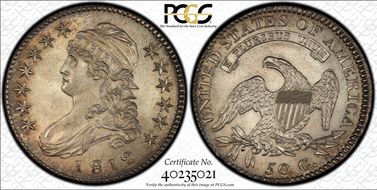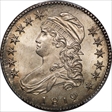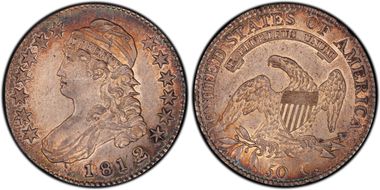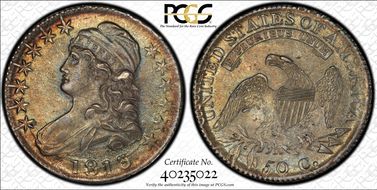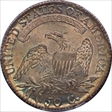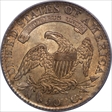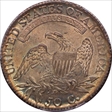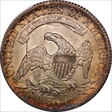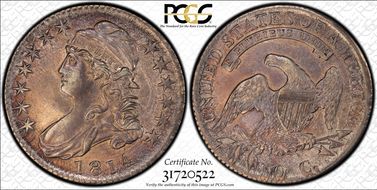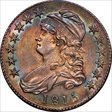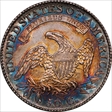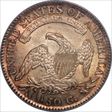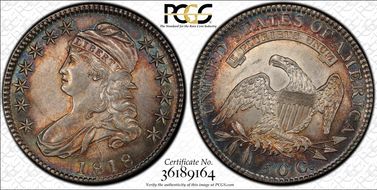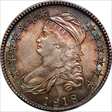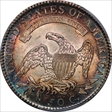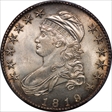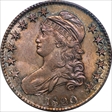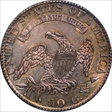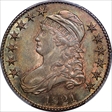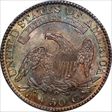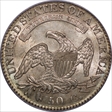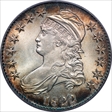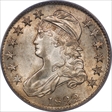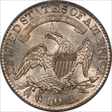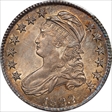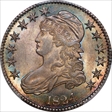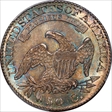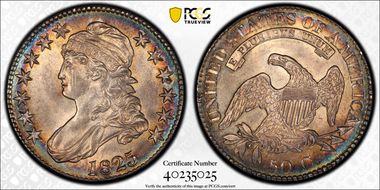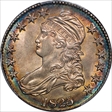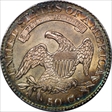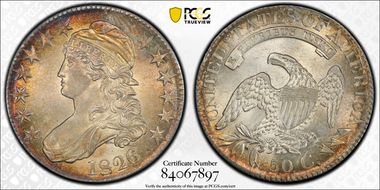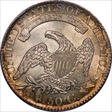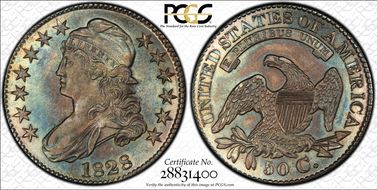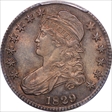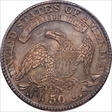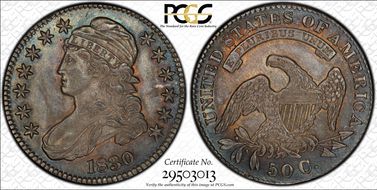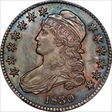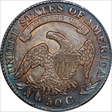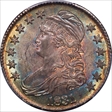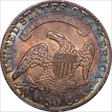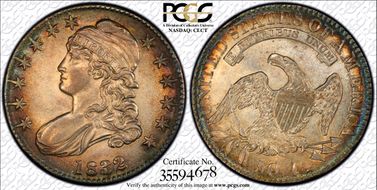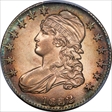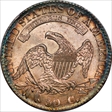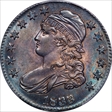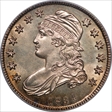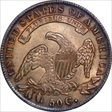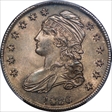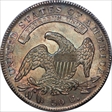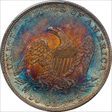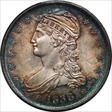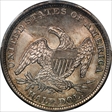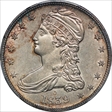The Coastal Collection (Major Varieties to '39) 的钱币相册
O.112, R1. CAC. Ex-Sears, ex-Osborne. Fabulous luster and flash.
O.112, R1. CAC. Ex-Sears, ex-Osborne. Fabulous luster and flash.
O.112, R1. CAC. Ex-Sears, ex-Osborne. Fabulous luster and flash.
O.113a, R2. Proof-like surfaces. LDS. This first-year capped bust is the small stars variety, the only such die marriage. It has the distinctive numeral one with its missing left base and the requisite peripheral die cracks, heads and tails, which identify its die state. This example has superb luster and colorful envelope toning. It is well struck with nicely impressed stars, full dentils, and crisp lettering.
O.113a, R2. Proof-like surfaces. LDS. This first-year capped bust is the small stars variety, the only such die marriage. It has the distinctive numeral one with its missing left base and the requisite peripheral die cracks, heads and tails, which identify its die state. This example has superb luster and colorful envelope toning. It is well struck with nicely impressed stars, full dentils, and crisp lettering.
O.114, R3. 1807 is the birth year of the capped bust half, though it shared the year with the last of the draped busts. Officially 750k were minted but most believe the true number to be less than half that (all that from just four die marriages?). Strike is usually soft due to the inherent weaknesses of the design. But these weaknesses (dentils, LIBERTY, stars, clasp, scroll, etc.) are very inconsistent. Which makes accurate grading a real challenge. This variety is sometimes called the real large stars, not the more common O.112 that PCGS also calls large stars but is properly known as 50/20 variety.
O.114, R3. 1807 is the birth year of the capped bust half, though it shared the year with the last of the draped busts. Officially 750k were minted but most believe the true number to be less than half that (all that from just four die marriages?). Strike is usually soft due to the inherent weaknesses of the design. But these weaknesses (dentils, LIBERTY, stars, clasp, scroll, etc.) are very inconsistent. Which makes accurate grading a real challenge. This variety is sometimes called the real large stars, not the more common O.112 that PCGS also calls large stars but is properly known as 50/20 variety.
O.114, R3. 1807 is the birth year of the capped bust half, though it shared the year with the last of the draped busts. Officially 750k were minted but most believe the true number to be less than half that (all that from just four die marriages?). Strike is usually soft due to the inherent weaknesses of the design. But these weaknesses (dentils, LIBERTY, stars, clasp, scroll, etc.) are very inconsistent. Which makes accurate grading a real challenge. This variety is sometimes called the real large stars, not the more common O.112 that PCGS also calls large stars but is properly known as 50/20 variety.
O.111b, R4. CAC. Catalog description (was NGC VF20 cert# 1981275-001): The 1807 Bearded Goddess best of all worlds for Bust half collectors. The design is the two-year Capped Bust type by John Reich, and the O-111b variety features the popular 50/20 reverse at the denomination, with the five struck over a partially effaced 2. But the main attraction is the dominant die crack most visible between Liberty's chin and chest. On high-grade, late die state coins the crack is visible from the headband, through the eye and face, and traveling downward across the bust to the left of the date. On moderately circulated coins such as the current example, the main break beneath the chin remains clear and dramatic. Gunmetal blue accents enhance the old-silver appeal of this smoothly worn bearded lady. A tiny planchet flaw between R and I of AMERICA on the reverse does not distract from the substantial appeal.
O.111b, R4. CAC. Catalog description (was NGC VF20 cert# 1981275-001): The 1807 Bearded Goddess best of all worlds for Bust half collectors. The design is the two-year Capped Bust type by John Reich, and the O-111b variety features the popular 50/20 reverse at the denomination, with the five struck over a partially effaced 2. But the main attraction is the dominant die crack most visible between Liberty's chin and chest. On high-grade, late die state coins the crack is visible from the headband, through the eye and face, and traveling downward across the bust to the left of the date. On moderately circulated coins such as the current example, the main break beneath the chin remains clear and dramatic. Gunmetal blue accents enhance the old-silver appeal of this smoothly worn bearded lady. A tiny planchet flaw between R and I of AMERICA on the reverse does not distract from the substantial appeal.
O.111b, R4. CAC. Catalog description (was NGC VF20 cert# 1981275-001): The 1807 Bearded Goddess best of all worlds for Bust half collectors. The design is the two-year Capped Bust type by John Reich, and the O-111b variety features the popular 50/20 reverse at the denomination, with the five struck over a partially effaced 2. But the main attraction is the dominant die crack most visible between Liberty's chin and chest. On high-grade, late die state coins the crack is visible from the headband, through the eye and face, and traveling downward across the bust to the left of the date. On moderately circulated coins such as the current example, the main break beneath the chin remains clear and dramatic. Gunmetal blue accents enhance the old-silver appeal of this smoothly worn bearded lady. A tiny planchet flaw between R and I of AMERICA on the reverse does not distract from the substantial appeal.
O.103, R1. 1808 was the second year for Capped Bust Half dollars using design type #1 from the original hubs. As such pieces from 1808 share the same design as 1807 halves but also striking traits...typically weak in areas, and die deterioration...cracks and die failure due to both design (device location) and steel quality and hardening difficulties. With almost 1.4 million minted and many survivors of this early type, the 1808 is not rare. Higher grade survivors become scare at the AU level and higher. Ten die marriages are known with the O.110 being the most difficult to acquire (R4 ). The 1808/7 overdate is ever-popular as the first overdate of the CBH series.
O.103, R1. 1808 was the second year for Capped Bust Half dollars using design type #1 from the original hubs. As such pieces from 1808 share the same design as 1807 halves but also striking traits...typically weak in areas, and die deterioration...cracks and die failure due to both design (device location) and steel quality and hardening difficulties. With almost 1.4 million minted and many survivors of this early type, the 1808 is not rare. Higher grade survivors become scare at the AU level and higher. Ten die marriages are known with the O.110 being the most difficult to acquire (R4 ). The 1808/7 overdate is ever-popular as the first overdate of the CBH series.
O.103, R1. 1808 was the second year for Capped Bust Half dollars using design type #1 from the original hubs. As such pieces from 1808 share the same design as 1807 halves but also striking traits...typically weak in areas, and die deterioration...cracks and die failure due to both design (device location) and steel quality and hardening difficulties. With almost 1.4 million minted and many survivors of this early type, the 1808 is not rare. Higher grade survivors become scare at the AU level and higher. Ten die marriages are known with the O.110 being the most difficult to acquire (R4 ). The 1808/7 overdate is ever-popular as the first overdate of the CBH series.
O.101, R1. CAC. Ex-Davignon. Hammered! Sheridan Downey's catalog description: Ex Gerald Schertz. The surfaces, while virtually free of contact marks, feature a wonderful morass of die breaks and clash marks. Only a peacock might aspire to the range of iridescent colors that grab and hold the viewer’s eye. Keith purchased the coin from me in June 1994; it was part of the nearly complete die variety set of Dr. Gerald Schertz, BHNC #45.
O.101, R1. CAC. Ex-Davignon. Hammered! Sheridan Downey's catalog description: Ex Gerald Schertz. The surfaces, while virtually free of contact marks, feature a wonderful morass of die breaks and clash marks. Only a peacock might aspire to the range of iridescent colors that grab and hold the viewer’s eye. Keith purchased the coin from me in June 1994; it was part of the nearly complete die variety set of Dr. Gerald Schertz, BHNC #45.
O.105, R1. CAC. ex-David Kahn. Catalog description: Fully struck obverse. All 13 stars display center points. The reverse is comparable, with slight weakness at top of left wing. Cartwheel luster rolls beneath the medium grey antique toning. Here is a lovely 1809 for a top flight collection!
O.105, R1. CAC. ex-David Kahn. Catalog description: Fully struck obverse. All 13 stars display center points. The reverse is comparable, with slight weakness at top of left wing. Cartwheel luster rolls beneath the medium grey antique toning. Here is a lovely 1809 for a top flight collection!
O.102a, R1. This variety is notable, and was collected for its different edge lettering. For reasons we can only guess, four of 1809's 15 varieties have XXX characters stamped into the edge. Four other varieties used III inscriptions. (One variety, the O.108 shows both.) A good guess is that this was done to repair flawed die bars but no one really knows. According to Ivan Leaman and Donald Gunnet's 1986 report, Edges and Die Sequences on Early Half Dollars... ...three of the 1809 edges bear ornamentation and are called the experimental edges. The third edge exhibits heavy vertical grooves at the beginning of each bar in front of FIFTY and HALF. The fourth edge is called the engrailed edge. There is a series of X-like figures at the front of the first bar and at the end of the second. The sixth edge contains only 106. There are light grooves in the front of HALF. We call this the pseudo-engrailed edge.
O.102a, R1. This variety is notable, and was collected for its different edge lettering. For reasons we can only guess, four of 1809's 15 varieties have XXX characters stamped into the edge. Four other varieties used III inscriptions. (One variety, the O.108 shows both.) A good guess is that this was done to repair flawed die bars but no one really knows. According to Ivan Leaman and Donald Gunnet's 1986 report, Edges and Die Sequences on Early Half Dollars... ...three of the 1809 edges bear ornamentation and are called the experimental edges. The third edge exhibits heavy vertical grooves at the beginning of each bar in front of FIFTY and HALF. The fourth edge is called the engrailed edge. There is a series of X-like figures at the front of the first bar and at the end of the second. The sixth edge contains only 106. There are light grooves in the front of HALF. We call this the pseudo-engrailed edge.
O.107a, R3. CAC. This variety is notable, and was collected for its different edge lettering. For reasons we can only guess, four of 1809's 15 varieties have XXX characters stamped into the edge. Four other varieties used III inscriptions. (One variety, the O.108 shows both.) A good guess is that this was done to repair flawed die bars but no one really knows. According to Ivan Leaman and Donald Gunnet's 1986 report, Edges and Die Sequences on Early Half Dollars... ...three of the 1809 edges bear ornamentation and are called the experimental edges. The third edge exhibits heavy vertical grooves at the beginning of each bar in front of FIFTY and HALF. The fourth edge is called the engrailed edge. There is a series of X-like figures at the front of the first bar and at the end of the second. The sixth edge contains only 106. There are light grooves in the front of HALF. We call this the pseudo-engrailed edge.
O.107a, R3. CAC. This variety is notable, and was collected for its different edge lettering. For reasons we can only guess, four of 1809's 15 varieties have XXX characters stamped into the edge. Four other varieties used III inscriptions. (One variety, the O.108 shows both.) A good guess is that this was done to repair flawed die bars but no one really knows. According to Ivan Leaman and Donald Gunnet's 1986 report, Edges and Die Sequences on Early Half Dollars... ...three of the 1809 edges bear ornamentation and are called the experimental edges. The third edge exhibits heavy vertical grooves at the beginning of each bar in front of FIFTY and HALF. The fourth edge is called the engrailed edge. There is a series of X-like figures at the front of the first bar and at the end of the second. The sixth edge contains only 106. There are light grooves in the front of HALF. We call this the pseudo-engrailed edge.
O.103a, R4. Exotic is a great way to describe the look and appeal of this somewhat scarce die marriage. Intense, deep chocolate brown dominates the obverse, blending into sea green rims. Mauve paints the reverse yielding to more blue/green. Nice luster flashes underneath all this, spewing splashy iridescence as the coin is rotated in hand. Clashing enthusiasts will love the crisp impression of eagle on the obverse with the rare appearance of leaves and berries at Liberty's forehead and arrowheads atop her cap. Signs of die erosion and fatigue are obvious on each side with significant die cracks at 1811 and 50 C. In spite of the LDS a good strike produces full details (curls, clasp, banner, feathers) with only a touch of weakness at TA and the upper left wing. ex-Pittman, lot 1459
O.103a, R4. Exotic is a great way to describe the look and appeal of this somewhat scarce die marriage. Intense, deep chocolate brown dominates the obverse, blending into sea green rims. Mauve paints the reverse yielding to more blue/green. Nice luster flashes underneath all this, spewing splashy iridescence as the coin is rotated in hand. Clashing enthusiasts will love the crisp impression of eagle on the obverse with the rare appearance of leaves and berries at Liberty's forehead and arrowheads atop her cap. Signs of die erosion and fatigue are obvious on each side with significant die cracks at 1811 and 50 C. In spite of the LDS a good strike produces full details (curls, clasp, banner, feathers) with only a touch of weakness at TA and the upper left wing. ex-Pittman, lot 1459
O.101, R1. This overdate, often called the punctuated date is from one of two die marriages (O.102 is the other). Look closely and you can see much of the 0 under the 3rd 1. There is a bold die dot between 8 and 1. And depending on who you believe the fragment between the two 1's is either from another nick in the die or it is what is left over from the earlier 1. In general the strike is just fine on these overdates but the relief is usually not as good as the yeardates due to lapping. Stars are always weak on the left obverse of the O.101 and, oddly, just the opposite on the O.102., same die. How can that be? Only a remarriage explains it (but you have to wonder why remarriages ever happen).
O.101, R1. This overdate, often called the punctuated date is from one of two die marriages (O.102 is the other). Look closely and you can see much of the 0 under the 3rd 1. There is a bold die dot between 8 and 1. And depending on who you believe the fragment between the two 1's is either from another nick in the die or it is what is left over from the earlier 1. In general the strike is just fine on these overdates but the relief is usually not as good as the yeardates due to lapping. Stars are always weak on the left obverse of the O.101 and, oddly, just the opposite on the O.102., same die. How can that be? Only a remarriage explains it (but you have to wonder why remarriages ever happen).
O.109, R2. Catalogers comments: Ex Dr. Charles Link and so-noted on the PCGS label. A top-flight example that is sharply struck with extravagant luster. Liberty’s curls are amazing. Every strand is in bold relief. The eagle’s feathers are a match, distinct and unruffled. Largely untoned, though a gossamer veil of gold toning suggests recent storage in a Kraft envelope.
O.109, R2. Catalogers comments: Ex Dr. Charles Link and so-noted on the PCGS label. A top-flight example that is sharply struck with extravagant luster. Liberty’s curls are amazing. Every strand is in bold relief. The eagle’s feathers are a match, distinct and unruffled. Largely untoned, though a gossamer veil of gold toning suggests recent storage in a Kraft envelope.
O.109, R2. Catalogers comments: Ex Dr. Charles Link and so-noted on the PCGS label. A top-flight example that is sharply struck with extravagant luster. Liberty’s curls are amazing. Every strand is in bold relief. The eagle’s feathers are a match, distinct and unruffled. Largely untoned, though a gossamer veil of gold toning suggests recent storage in a Kraft envelope.
O.102, R2. CAC. The 1812 overdates are not as well struck as the yeardates which were the product of a different MD. Adding to the problem is the fact that most overdates received quite a bit of die lapping to remove or minimize traces of the underdate. The over all impression leaves one to conclude that these coins appear more worn than they likely are. This extremely lustrous, colorful small-8 overdate has a slightly better than average strike (obverse) paired with a very nice EDS reverse. The thick skin adds a feeling of originality.
O.102, R2. CAC. The 1812 overdates are not as well struck as the yeardates which were the product of a different MD. Adding to the problem is the fact that most overdates received quite a bit of die lapping to remove or minimize traces of the underdate. The over all impression leaves one to conclude that these coins appear more worn than they likely are. This extremely lustrous, colorful small-8 overdate has a slightly better than average strike (obverse) paired with a very nice EDS reverse. The thick skin adds a feeling of originality.
O.102, R2. CAC. The 1812 overdates are not as well struck as the yeardates which were the product of a different MD. Adding to the problem is the fact that most overdates received quite a bit of die lapping to remove or minimize traces of the underdate. The over all impression leaves one to conclude that these coins appear more worn than they likely are. This extremely lustrous, colorful small-8 overdate has a slightly better than average strike (obverse) paired with a very nice EDS reverse. The thick skin adds a feeling of originality.
O.102, R2. CAC. The 1812 overdates are not as well struck as the yeardates which were the product of a different MD. Adding to the problem is the fact that most overdates received quite a bit of die lapping to remove or minimize traces of the underdate. The over all impression leaves one to conclude that these coins appear more worn than they likely are. This extremely lustrous, colorful small-8 overdate has a slightly better than average strike (obverse) paired with a very nice EDS reverse. The thick skin adds a feeling of originality.
O.101, R5. Lovely original, problem-free specimen attractively toned from album storage. Looks like a technical VF35 given a bump for its eye appeal.
O.101, R5. Lovely original, problem-free specimen attractively toned from album storage. Looks like a technical VF35 given a bump for its eye appeal.
O.109, R3. LDS and probably equivalent to O.109a R5, the so-called single leaf. Through either excessive die wear or die lapping, as evidenced here, the 2nd leaf has been lost. On high grade specimens like this a trace of the 2nd leaf often shows.
O.109, R3. LDS and probably equivalent to O.109a R5, the so-called single leaf. Through either excessive die wear or die lapping, as evidenced here, the 2nd leaf has been lost. On high grade specimens like this a trace of the 2nd leaf often shows.
O.109, R3. LDS and probably equivalent to O.109a R5, the so-called single leaf. Through either excessive die wear or die lapping, as evidenced here, the 2nd leaf has been lost. On high grade specimens like this a trace of the 2nd leaf often shows.
O.101, R2. CAC. A popular variety, the 50C/UNI gets its name from the obviously botched lower reverse. In one of the most spectacular errors, the engraver (Reich) lost his point of reference and punched UNI at the 5 o'clock position (instead of 8:30) before realizing his blunder. Scraping, and later lapping, was done but traces remained as this example shows.
O.101, R2. CAC. A popular variety, the 50C/UNI gets its name from the obviously botched lower reverse. In one of the most spectacular errors, the engraver (Reich) lost his point of reference and punched UNI at the 5 o'clock position (instead of 8:30) before realizing his blunder. Scraping, and later lapping, was done but traces remained as this example shows.
O.101, R2. CAC. A popular variety, the 50C/UNI gets its name from the obviously botched lower reverse. In one of the most spectacular errors, the engraver (Reich) lost his point of reference and punched UNI at the 5 o'clock position (instead of 8:30) before realizing his blunder. Scraping, and later lapping, was done but traces remained as this example shows.
O.101, R2. CAC. A popular variety, the 50C/UNI gets its name from the obviously botched lower reverse. In one of the most spectacular errors, the engraver (Reich) lost his point of reference and punched UNI at the 5 o'clock position (instead of 8:30) before realizing his blunder. Scraping, and later lapping, was done but traces remained as this example shows.
O.101a. R2. One of the more popular overdates, the 1814/3 die marriage rapidly deteriorated, producing various die states. Two are fundamental: O.101 without die cracks and O.101a, with. The former is an R6 which testifies to the rapid decline of the dies. Besides the plain overdate there are other notable traits of this die pair. Two dentils north of the second T in STATES, e.g., are oversized and the left one is attached to the T with a die defect. The dies clashing no doubt contributed to their spectacular failure. This example is an early die state for the late O.101a, and is very well struck for the issue (the left wing is always weak on these). It appears original, handsomely toned and remarkably lustrous.
O.101a. R2. One of the more popular overdates, the 1814/3 die marriage rapidly deteriorated, producing various die states. Two are fundamental: O.101 without die cracks and O.101a, with. The former is an R6 which testifies to the rapid decline of the dies. Besides the plain overdate there are other notable traits of this die pair. Two dentils north of the second T in STATES, e.g., are oversized and the left one is attached to the T with a die defect. The dies clashing no doubt contributed to their spectacular failure. This example is an early die state for the late O.101a, and is very well struck for the issue (the left wing is always weak on these). It appears original, handsomely toned and remarkably lustrous.
O.108a, R1. Nine die marriages were produced from a mintage of just over 1 million, the fourth lowest of the series. Among these nine marriages were the 1814/3 overdate, the very scarce single leaf and the major variety E over A. Here is the interesting E over A. Speculation is that the A punched into STATES instead of the correct E was not a matter of illiteracy by the help or a spelling error by Reich. It was likely due to a distraction that caused Reich to lose his place. Seeing a T and little more (under magnification) he didn't realize he was about to strike the fifth letter, not the third. I wonder what expletive he uttered. This die marriage is heavily clashed and LDS's are very eroded. Typical soft spots include the eagle's left wing and head. This better struck example has a pleasant rose, orange, and pale blue hue, not as intense as the True View picture. ex-Eastern Woods II.
O.108a, R1. Nine die marriages were produced from a mintage of just over 1 million, the fourth lowest of the series. Among these nine marriages were the 1814/3 overdate, the very scarce single leaf and the major variety E over A. Here is the interesting E over A. Speculation is that the A punched into STATES instead of the correct E was not a matter of illiteracy by the help or a spelling error by Reich. It was likely due to a distraction that caused Reich to lose his place. Seeing a T and little more (under magnification) he didn't realize he was about to strike the fifth letter, not the third. I wonder what expletive he uttered. This die marriage is heavily clashed and LDS's are very eroded. Typical soft spots include the eagle's left wing and head. This better struck example has a pleasant rose, orange, and pale blue hue, not as intense as the True View picture. ex-Eastern Woods II.
O.108a, R1. Nine die marriages were produced from a mintage of just over 1 million, the fourth lowest of the series. Among these nine marriages were the 1814/3 overdate, the very scarce single leaf and the major variety E over A. Here is the interesting E over A. Speculation is that the A punched into STATES instead of the correct E was not a matter of illiteracy by the help or a spelling error by Reich. It was likely due to a distraction that caused Reich to lose his place. Seeing a T and little more (under magnification) he didn't realize he was about to strike the fifth letter, not the third. I wonder what expletive he uttered. This die marriage is heavily clashed and LDS's are very eroded. Typical soft spots include the eagle's left wing and head. This better struck example has a pleasant rose, orange, and pale blue hue, not as intense as the True View picture. ex-Eastern Woods II.
O.108a, R1. Nine die marriages were produced from a mintage of just over 1 million, the fourth lowest of the series. Among these nine marriages were the 1814/3 overdate, the very scarce single leaf and the major variety E over A. Here is the interesting E over A. Speculation is that the A punched into STATES instead of the correct E was not a matter of illiteracy by the help or a spelling error by Reich. It was likely due to a distraction that caused Reich to lose his place. Seeing a T and little more (under magnification) he didn't realize he was about to strike the fifth letter, not the third. I wonder what expletive he uttered. This die marriage is heavily clashed and LDS's are very eroded. Typical soft spots include the eagle's left wing and head. This better struck example has a pleasant rose, orange, and pale blue hue, not as intense as the True View picture. ex-Eastern Woods II.
O.108a, R1. Nine die marriages were produced from a mintage of just over 1 million, the fourth lowest of the series. Among these nine marriages were the 1814/3 overdate, the very scarce single leaf and the major variety E over A. Here is the interesting E over A. Speculation is that the A punched into STATES instead of the correct E was not a matter of illiteracy by the help or a spelling error by Reich. It was likely due to a distraction that caused Reich to lose his place. Seeing a T and little more (under magnification) he didn't realize he was about to strike the fifth letter, not the third. I wonder what expletive he uttered. This die marriage is heavily clashed and LDS's are very eroded. Typical soft spots include the eagle's left wing and head. This better struck example has a pleasant rose, orange, and pale blue hue, not as intense as the True View picture. ex-Eastern Woods II.
O.101, R2. CAC. From the George Hamilton collection, lot 4093. Originally housed in an NGC old fattie graded AU55 with a CAC gold sticker. The catalog description: It is challenging to find an 1815/2 half dollar with any degree of eye appeal. They are by and large a dull lot, and many of the surviving pieces are impaired in one way or another. The present coin is a wonderful exception. Originally toned in attractive blue, violet, and tangerine-gold toning, both sides are brightly lustrous and sharply struck. Aside from the inevitable die clashing, there are no marks of consequence. Housed in an early generation NGC holder from about 25 years ago (with hologram but without the barcode), this Choice About Uncirculated coin carries the CAC gold sticker indicating it is undergraded by at least one level. An interesting bit of trivia about the 1815/2 is that the entire lot of coins struck in early Jan 1816 were paid out to a single customer: Jones, Firth and Co. How often can we trace provenance and know with certainty the original owner?
O.101, R2. CAC. From the George Hamilton collection, lot 4093. Originally housed in an NGC old fattie graded AU55 with a CAC gold sticker. The catalog description: It is challenging to find an 1815/2 half dollar with any degree of eye appeal. They are by and large a dull lot, and many of the surviving pieces are impaired in one way or another. The present coin is a wonderful exception. Originally toned in attractive blue, violet, and tangerine-gold toning, both sides are brightly lustrous and sharply struck. Aside from the inevitable die clashing, there are no marks of consequence. Housed in an early generation NGC holder from about 25 years ago (with hologram but without the barcode), this Choice About Uncirculated coin carries the CAC gold sticker indicating it is undergraded by at least one level. An interesting bit of trivia about the 1815/2 is that the entire lot of coins struck in early Jan 1816 were paid out to a single customer: Jones, Firth and Co. How often can we trace provenance and know with certainty the original owner?
O.101, R2. CAC. From the George Hamilton collection, lot 4093. Originally housed in an NGC old fattie graded AU55 with a CAC gold sticker. The catalog description: It is challenging to find an 1815/2 half dollar with any degree of eye appeal. They are by and large a dull lot, and many of the surviving pieces are impaired in one way or another. The present coin is a wonderful exception. Originally toned in attractive blue, violet, and tangerine-gold toning, both sides are brightly lustrous and sharply struck. Aside from the inevitable die clashing, there are no marks of consequence. Housed in an early generation NGC holder from about 25 years ago (with hologram but without the barcode), this Choice About Uncirculated coin carries the CAC gold sticker indicating it is undergraded by at least one level. An interesting bit of trivia about the 1815/2 is that the entire lot of coins struck in early Jan 1816 were paid out to a single customer: Jones, Firth and Co. How often can we trace provenance and know with certainty the original owner?
O.101, R2. CAC. From the George Hamilton collection, lot 4093. Originally housed in an NGC old fattie graded AU55 with a CAC gold sticker. The catalog description: It is challenging to find an 1815/2 half dollar with any degree of eye appeal. They are by and large a dull lot, and many of the surviving pieces are impaired in one way or another. The present coin is a wonderful exception. Originally toned in attractive blue, violet, and tangerine-gold toning, both sides are brightly lustrous and sharply struck. Aside from the inevitable die clashing, there are no marks of consequence. Housed in an early generation NGC holder from about 25 years ago (with hologram but without the barcode), this Choice About Uncirculated coin carries the CAC gold sticker indicating it is undergraded by at least one level. An interesting bit of trivia about the 1815/2 is that the entire lot of coins struck in early Jan 1816 were paid out to a single customer: Jones, Firth and Co. How often can we trace provenance and know with certainty the original owner?
O.113a, R4. OGH Cataloger's description: An intensely lustrous example with a ring of pastel rose and copper toning that floats through the stars and legend. Die breaks pass through and over the date. The surfaces are free of blemishes save for a short hairline at the tip of star 4. This is an eye-catching coin! From the Davignon Collection, acquired at Stack’s-Bowers’ Nov. 2012 Baltimore sale, lot 1676.
O.113a, R4. OGH Cataloger's description: An intensely lustrous example with a ring of pastel rose and copper toning that floats through the stars and legend. Die breaks pass through and over the date. The surfaces are free of blemishes save for a short hairline at the tip of star 4. This is an eye-catching coin! From the Davignon Collection, acquired at Stack’s-Bowers’ Nov. 2012 Baltimore sale, lot 1676.
O.103. R2. Besides the overdates there are two notable varieties. The single leaf O.106a (a result of lapping) and the punctuated date O.103 (likely from a dropped object on a softened die).
O.103. R2. Besides the overdates there are two notable varieties. The single leaf O.106a (a result of lapping) and the punctuated date O.103 (likely from a dropped object on a softened die).
O.103. R2. Besides the overdates there are two notable varieties. The single leaf O.106a (a result of lapping) and the punctuated date O.103 (likely from a dropped object on a softened die).
O.101a, R2. The 1817/3 is a very popular overdate, as the underlying 3 is patently visible on the lone die marriage (the presence of the reverse die crack, from M in AMERICA through the denomination and up along UNITED, is what distinguishes this later die state). It is relatively scarce in all grades and downright difficult in grades above VF. Weak strikes are common with the usual difficult locations: eagle's left wing, head and beak, the obverse center. Even Liberty's profile is known to be poorly struck.
O.101a, R2. The 1817/3 is a very popular overdate, as the underlying 3 is patently visible on the lone die marriage (the presence of the reverse die crack, from M in AMERICA through the denomination and up along UNITED, is what distinguishes this later die state). It is relatively scarce in all grades and downright difficult in grades above VF. Weak strikes are common with the usual difficult locations: eagle's left wing, head and beak, the obverse center. Even Liberty's profile is known to be poorly struck.
O.101a, R2. The 1817/3 is a very popular overdate, as the underlying 3 is patently visible on the lone die marriage (the presence of the reverse die crack, from M in AMERICA through the denomination and up along UNITED, is what distinguishes this later die state). It is relatively scarce in all grades and downright difficult in grades above VF. Weak strikes are common with the usual difficult locations: eagle's left wing, head and beak, the obverse center. Even Liberty's profile is known to be poorly struck.
O.102, R2. Here's a very special CBH, ex-Dick Graham, ex-Tom Palmer. Not only is it a desirable overdate and the unique marriage of the small 8. It is also an EDS and well struck to boot! The 1818 overdates were generally weak-to-good strikes. The small 8 was made from a new lowered-relief hub and generally appears weaker in the center. Yet this example is relatively strong in the center (curls and clasp are well defined) and comes from an early die. Note the complete dentils and well formed stars. Note too the absence of the filled upper loop of the second 8 which happened when a die chip broke off. The reverse is equally early and well defined. Top it all off with sunburst colors of orange and coral, and flashy blue rims with mark-free surfaces. Full, rolling luster on the reverse with just the slightest break on the obverse. (Was AU55 CAC cert# 30431364)
O.102, R2. Here's a very special CBH, ex-Dick Graham, ex-Tom Palmer. Not only is it a desirable overdate and the unique marriage of the small 8. It is also an EDS and well struck to boot! The 1818 overdates were generally weak-to-good strikes. The small 8 was made from a new lowered-relief hub and generally appears weaker in the center. Yet this example is relatively strong in the center (curls and clasp are well defined) and comes from an early die. Note the complete dentils and well formed stars. Note too the absence of the filled upper loop of the second 8 which happened when a die chip broke off. The reverse is equally early and well defined. Top it all off with sunburst colors of orange and coral, and flashy blue rims with mark-free surfaces. Full, rolling luster on the reverse with just the slightest break on the obverse. (Was AU55 CAC cert# 30431364)
O.102, R2. Here's a very special CBH, ex-Dick Graham, ex-Tom Palmer. Not only is it a desirable overdate and the unique marriage of the small 8. It is also an EDS and well struck to boot! The 1818 overdates were generally weak-to-good strikes. The small 8 was made from a new lowered-relief hub and generally appears weaker in the center. Yet this example is relatively strong in the center (curls and clasp are well defined) and comes from an early die. Note the complete dentils and well formed stars. Note too the absence of the filled upper loop of the second 8 which happened when a die chip broke off. The reverse is equally early and well defined. Top it all off with sunburst colors of orange and coral, and flashy blue rims with mark-free surfaces. Full, rolling luster on the reverse with just the slightest break on the obverse. (Was AU55 CAC cert# 30431364)
O.101a, R1. The large 8 overdate is represented by two die marriages sharing the same obverse WD. O.101 and O.103. The underlying 7 show its ears at the top and the bar connecting them are clearly visible. Often part of the leg of the 7 appears in the loops below. A nice, clear overdate. The large 8 variety is scarcer than the small 8, with the O.103 being very scarce at the XF grade. This example possesses dazzling luster and vivid, colorful toning.
O.101a, R1. The large 8 overdate is represented by two die marriages sharing the same obverse WD. O.101 and O.103. The underlying 7 show its ears at the top and the bar connecting them are clearly visible. Often part of the leg of the 7 appears in the loops below. A nice, clear overdate. The large 8 variety is scarcer than the small 8, with the O.103 being very scarce at the XF grade. This example possesses dazzling luster and vivid, colorful toning.
O.101a, R1. The large 8 overdate is represented by two die marriages sharing the same obverse WD. O.101 and O.103. The underlying 7 show its ears at the top and the bar connecting them are clearly visible. Often part of the leg of the 7 appears in the loops below. A nice, clear overdate. The large 8 variety is scarcer than the small 8, with the O.103 being very scarce at the XF grade. This example possesses dazzling luster and vivid, colorful toning.
O.115, R3. During 1819 the Mint struck a respectable 2.2 million half dollars using fifteen different die marriages. Five were overdates and ten, yeardates.
O.115, R3. During 1819 the Mint struck a respectable 2.2 million half dollars using fifteen different die marriages. Five were overdates and ten, yeardates.
O.101, R1 Shown here is the unique small 9 overdate marriage and the first of a total of five. The underlying 8 is plain to see in several places around the lower section of the nine. The obverse, shrouded in electric blue, shows striking detail, particularly evident in the hair curls, star centers and points, and in the drapery folds. Overdates are rarely struck-up well. Previously used dies are often lapped in preparation of the numeral change and the die's reuse. The reverse mimics the obverse's color at the rims which then blends to pretty sunset toning. Although graded AU58 by PCGS, the half shows no sign of rub or wear at all, and should probably be graded MS.
O.101, R1 Shown here is the unique small 9 overdate marriage and the first of a total of five. The underlying 8 is plain to see in several places around the lower section of the nine. The obverse, shrouded in electric blue, shows striking detail, particularly evident in the hair curls, star centers and points, and in the drapery folds. Overdates are rarely struck-up well. Previously used dies are often lapped in preparation of the numeral change and the die's reuse. The reverse mimics the obverse's color at the rims which then blends to pretty sunset toning. Although graded AU58 by PCGS, the half shows no sign of rub or wear at all, and should probably be graded MS.
O.101, R1 Shown here is the unique small 9 overdate marriage and the first of a total of five. The underlying 8 is plain to see in several places around the lower section of the nine. The obverse, shrouded in electric blue, shows striking detail, particularly evident in the hair curls, star centers and points, and in the drapery folds. Overdates are rarely struck-up well. Previously used dies are often lapped in preparation of the numeral change and the die's reuse. The reverse mimics the obverse's color at the rims which then blends to pretty sunset toning. Although graded AU58 by PCGS, the half shows no sign of rub or wear at all, and should probably be graded MS.
O.103b (late die state, crack at 50c, rarity TBD). This example of a curl 2, small date was acquired for its unspoiled, original appearance. Rarely has a 200 year old silver coin not been conserved at some point in its life. This one appears to have lots of 19th century dirt. Nice and crusty with very respectable luster.
O.103b (late die state, crack at 50c, rarity TBD). This example of a curl 2, small date was acquired for its unspoiled, original appearance. Rarely has a 200 year old silver coin not been conserved at some point in its life. This one appears to have lots of 19th century dirt. Nice and crusty with very respectable luster.
O.104, R4. Eric P. Newman Collection, ex-Col. E.H.R. Green as NGC MS61 cert# 2037647-069
O.104, R4. Eric P. Newman Collection, ex-Col. E.H.R. Green as NGC MS61 cert# 2037647-069
O.104, R4. Eric P. Newman Collection, ex-Col. E.H.R. Green as NGC MS61 cert# 2037647-069
O.107, R.5 From the Sept 2021 Legend Auction (H. Scharfman collection). Ex. Floyd Farley Collection; to Charlton (Swampy) Meyers circa 1996; Selected Rarities from the Meyer Collection, Sheridan Downey Mail Bid, July 2008, lot 32 (as NGC AU58); Dr. Charles Link Collection; sold via private treaty to Keith Davignon April 2010; private treaty sale to Dr. Charles Link (as PCGS AU58), March 2014; private treaty sale to our consignor, April 2017 Catalog description: An extremely difficult Rarity 5 die marriage, the O-107 is about on par with the 1812/1 Large 8 in terms of number known. Identifiable by broken A and E punches on the reverse, missing the serifs of both letters. This impressive, borderline Uncirculated example has one of the greatest pedigrees for the Capped Bust half dollar connoisseurs--it reads as a who's who of old time and recent Bust Half Nuts! Only the slightest hint of friction can be detected by a strong glass, indeed PCGS got it right grade wise. The underlying luster is bold, and while this coin may have been dipped ages ago, storage in an old Kraft envelope since that time has imparted a lovely pastel blue, gold, and rose tone. Generally very well struck up overall, we note just a touch of weakness at the tip of the bust. The eye appeal is sensational for this incredibly RARE variety. PCGS 1, NGC 0. This coin sold privately in 2017 for $46,500 and the Don Frederick AU58 sold privately in June 2020 for $56,000.
O.107, R.5 From the Sept 2021 Legend Auction (H. Scharfman collection). Ex. Floyd Farley Collection; to Charlton (Swampy) Meyers circa 1996; Selected Rarities from the Meyer Collection, Sheridan Downey Mail Bid, July 2008, lot 32 (as NGC AU58); Dr. Charles Link Collection; sold via private treaty to Keith Davignon April 2010; private treaty sale to Dr. Charles Link (as PCGS AU58), March 2014; private treaty sale to our consignor, April 2017 Catalog description: An extremely difficult Rarity 5 die marriage, the O-107 is about on par with the 1812/1 Large 8 in terms of number known. Identifiable by broken A and E punches on the reverse, missing the serifs of both letters. This impressive, borderline Uncirculated example has one of the greatest pedigrees for the Capped Bust half dollar connoisseurs--it reads as a who's who of old time and recent Bust Half Nuts! Only the slightest hint of friction can be detected by a strong glass, indeed PCGS got it right grade wise. The underlying luster is bold, and while this coin may have been dipped ages ago, storage in an old Kraft envelope since that time has imparted a lovely pastel blue, gold, and rose tone. Generally very well struck up overall, we note just a touch of weakness at the tip of the bust. The eye appeal is sensational for this incredibly RARE variety. PCGS 1, NGC 0. This coin sold privately in 2017 for $46,500 and the Don Frederick AU58 sold privately in June 2020 for $56,000.
O.107, R.5 From the Sept 2021 Legend Auction (H. Scharfman collection). Ex. Floyd Farley Collection; to Charlton (Swampy) Meyers circa 1996; Selected Rarities from the Meyer Collection, Sheridan Downey Mail Bid, July 2008, lot 32 (as NGC AU58); Dr. Charles Link Collection; sold via private treaty to Keith Davignon April 2010; private treaty sale to Dr. Charles Link (as PCGS AU58), March 2014; private treaty sale to our consignor, April 2017 Catalog description: An extremely difficult Rarity 5 die marriage, the O-107 is about on par with the 1812/1 Large 8 in terms of number known. Identifiable by broken A and E punches on the reverse, missing the serifs of both letters. This impressive, borderline Uncirculated example has one of the greatest pedigrees for the Capped Bust half dollar connoisseurs--it reads as a who's who of old time and recent Bust Half Nuts! Only the slightest hint of friction can be detected by a strong glass, indeed PCGS got it right grade wise. The underlying luster is bold, and while this coin may have been dipped ages ago, storage in an old Kraft envelope since that time has imparted a lovely pastel blue, gold, and rose tone. Generally very well struck up overall, we note just a touch of weakness at the tip of the bust. The eye appeal is sensational for this incredibly RARE variety. PCGS 1, NGC 0. This coin sold privately in 2017 for $46,500 and the Don Frederick AU58 sold privately in June 2020 for $56,000.
O.101, R2. CAC 1820 was the 4th consecutive year for bust half overdates. And it was a spectacular one, with two varieties each of which boldly display the underrate. This is the square base 2 variety, somewhat scarcer, and while the underdate 9 may not be as prominent as the curl base 2 variety it shows the underdate 1 a tad better. The knob of the 9's tail can be seen at the lower left inside of the 0. Other researchers (Edgar Souder, William Atkinson) feel certain it is an 1820/19/18 based on microscopic image overlays. Both 1820/19's tend to carry a premium over price guides.
O.101, R2. CAC 1820 was the 4th consecutive year for bust half overdates. And it was a spectacular one, with two varieties each of which boldly display the underrate. This is the square base 2 variety, somewhat scarcer, and while the underdate 9 may not be as prominent as the curl base 2 variety it shows the underdate 1 a tad better. The knob of the 9's tail can be seen at the lower left inside of the 0. Other researchers (Edgar Souder, William Atkinson) feel certain it is an 1820/19/18 based on microscopic image overlays. Both 1820/19's tend to carry a premium over price guides.
O.101, R2. CAC 1820 was the 4th consecutive year for bust half overdates. And it was a spectacular one, with two varieties each of which boldly display the underrate. This is the square base 2 variety, somewhat scarcer, and while the underdate 9 may not be as prominent as the curl base 2 variety it shows the underdate 1 a tad better. The knob of the 9's tail can be seen at the lower left inside of the 0. Other researchers (Edgar Souder, William Atkinson) feel certain it is an 1820/19/18 based on microscopic image overlays. Both 1820/19's tend to carry a premium over price guides.
O.101a, R1. CAC. Provenance for this lovely half dollar dates back to violin virtuoso Jascha Heifetz. It was sold as part of his set by Superior Auctions in October 1989, lot 677, where it realized $3,960. In May 2008 it was sold by Heritage (Long Beach, 1108), lot 532, where it realized $3,738 as an NGC MS63, cert# 125439-008 (old fatty, no-line holder circa 1988-89). Ex Silbermünzen, Heifetz. Next is the Heritage 1173 (Philadelpha) sale in August 2012, lot 3392, where it realized $3,819 as PCGS MS63 (ex-Silberrmünzen), cert# 16142160. Finally it appeared in the Heritage 1329 (Dallas) sale in April 2021, lot 3465, where it realized $3,120 as PCGS MS63 (ex-Silbermünzen), cert. no. 28725897.
O.101a, R1. CAC. Provenance for this lovely half dollar dates back to violin virtuoso Jascha Heifetz. It was sold as part of his set by Superior Auctions in October 1989, lot 677, where it realized $3,960. In May 2008 it was sold by Heritage (Long Beach, 1108), lot 532, where it realized $3,738 as an NGC MS63, cert# 125439-008 (old fatty, no-line holder circa 1988-89). Ex Silbermünzen, Heifetz. Next is the Heritage 1173 (Philadelpha) sale in August 2012, lot 3392, where it realized $3,819 as PCGS MS63 (ex-Silberrmünzen), cert# 16142160. Finally it appeared in the Heritage 1329 (Dallas) sale in April 2021, lot 3465, where it realized $3,120 as PCGS MS63 (ex-Silbermünzen), cert. no. 28725897.
O.101a, R1. CAC. Provenance for this lovely half dollar dates back to violin virtuoso Jascha Heifetz. It was sold as part of his set by Superior Auctions in October 1989, lot 677, where it realized $3,960. In May 2008 it was sold by Heritage (Long Beach, 1108), lot 532, where it realized $3,738 as an NGC MS63, cert# 125439-008 (old fatty, no-line holder circa 1988-89). Ex Silbermünzen, Heifetz. Next is the Heritage 1173 (Philadelpha) sale in August 2012, lot 3392, where it realized $3,819 as PCGS MS63 (ex-Silberrmünzen), cert# 16142160. Finally it appeared in the Heritage 1329 (Dallas) sale in April 2021, lot 3465, where it realized $3,120 as PCGS MS63 (ex-Silbermünzen), cert. no. 28725897.
O.101a, R1. CAC. Provenance for this lovely half dollar dates back to violin virtuoso Jascha Heifetz. It was sold as part of his set by Superior Auctions in October 1989, lot 677, where it realized $3,960. In May 2008 it was sold by Heritage (Long Beach, 1108), lot 532, where it realized $3,738 as an NGC MS63, cert# 125439-008 (old fatty, no-line holder circa 1988-89). Ex Silbermünzen, Heifetz. Next is the Heritage 1173 (Philadelpha) sale in August 2012, lot 3392, where it realized $3,819 as PCGS MS63 (ex-Silberrmünzen), cert# 16142160. Finally it appeared in the Heritage 1329 (Dallas) sale in April 2021, lot 3465, where it realized $3,120 as PCGS MS63 (ex-Silbermünzen), cert. no. 28725897.
O.113, R3. NTS: regrade Cataloger's description: From the Davignon collection, found on the bourse floor during the 2003 ANA Convention. A blast of vibrant luster greets the eye. Frosty, untoned centers are framed with halos of russet toning. There is not a hint of friction on the devices; contact marks are virtually non-existent. The strike is first rate. In short, an ideal coin for an ambitious type or date collector. This was the last coin consigned to the sale. Keith uncovered and purchased an ethereal `22-113 at the recent Baltimore show. He explained, “[It] did indeed turn out to be a [George] Plimpton [family] Hoard coin. It was lot 700 in the 1981 NASCA sale of the Providence Collection, one of the 3 confirmed Plimpton Hoard auctions. I was able to identify it with 100% certainty from position of minor toning spots in the catalog photos.” Keith’s sleuthing and good fortune shook loose the coin offered here.
O.113, R3. NTS: regrade Cataloger's description: From the Davignon collection, found on the bourse floor during the 2003 ANA Convention. A blast of vibrant luster greets the eye. Frosty, untoned centers are framed with halos of russet toning. There is not a hint of friction on the devices; contact marks are virtually non-existent. The strike is first rate. In short, an ideal coin for an ambitious type or date collector. This was the last coin consigned to the sale. Keith uncovered and purchased an ethereal `22-113 at the recent Baltimore show. He explained, “[It] did indeed turn out to be a [George] Plimpton [family] Hoard coin. It was lot 700 in the 1981 NASCA sale of the Providence Collection, one of the 3 confirmed Plimpton Hoard auctions. I was able to identify it with 100% certainty from position of minor toning spots in the catalog photos.” Keith’s sleuthing and good fortune shook loose the coin offered here.
O.101, R1. 1823 gave us some fun varieties, particularly due to weird 3 numerals in the date. We have the broken 3, patched 3, ugly 3...even the tampered-with 3. The 3 punch had not been used in 10 years and the new style punch, with its curvy upper loop (as opposed to a straight top 3 last used in 1813,) is believed to have been defective. But deemed good enough. It was used to produce O.101 broken 3 halves. Al Overton suggested that the top half of a 2 punch was used twice and that is why the 3 appears broken. But diagnostics prove the shape was not correct. Early research blamed an inept Mint worker, substituting for a gravely ill Robert Scot (Kneass was not hired until Jan 1824). It is illogical to assume he blundered just once and afterward produced flawless 3's. Whatever the case the broken 3 variety is very collectible and it took a few purchases before this one was acquired. It was submitted for photographing and was purchased on the spot. It has a lovely album toning appearance, awash in sea blue and green, marigold and rust, with splendid luster, and virtually mark-free surfaces.
O.101, R1. 1823 gave us some fun varieties, particularly due to weird 3 numerals in the date. We have the broken 3, patched 3, ugly 3...even the tampered-with 3. The 3 punch had not been used in 10 years and the new style punch, with its curvy upper loop (as opposed to a straight top 3 last used in 1813,) is believed to have been defective. But deemed good enough. It was used to produce O.101 broken 3 halves. Al Overton suggested that the top half of a 2 punch was used twice and that is why the 3 appears broken. But diagnostics prove the shape was not correct. Early research blamed an inept Mint worker, substituting for a gravely ill Robert Scot (Kneass was not hired until Jan 1824). It is illogical to assume he blundered just once and afterward produced flawless 3's. Whatever the case the broken 3 variety is very collectible and it took a few purchases before this one was acquired. It was submitted for photographing and was purchased on the spot. It has a lovely album toning appearance, awash in sea blue and green, marigold and rust, with splendid luster, and virtually mark-free surfaces.
O.101a, R1. At some point Mint officials chose to touch up the WD that had been producing broken 3 varieties. The results would turn out less than graceful. The softened die was struck with a short blunt punch to impart a connection to the separated 3 pieces and the patched 3 was born. The die was placed back in service (O.101a) and later mated to a new reverse (O.102), giving us two die marriages. This example is one of the prettiest I have come across with its rose and amber central toning and blue rims with a touch of brick red. Full luster and clean surfaces give it strikingly strong eye appeal.
O.101a, R1. At some point Mint officials chose to touch up the WD that had been producing broken 3 varieties. The results would turn out less than graceful. The softened die was struck with a short blunt punch to impart a connection to the separated 3 pieces and the patched 3 was born. The die was placed back in service (O.101a) and later mated to a new reverse (O.102), giving us two die marriages. This example is one of the prettiest I have come across with its rose and amber central toning and blue rims with a touch of brick red. Full luster and clean surfaces give it strikingly strong eye appeal.
O.110a, R3, ex-CAC (different cert#). Ex-Troy Nelson (Allgood collection), ex-Dick Graham. Dirty, proof-like surfaces. A lot can be said about the troublesome 3 in the 1823 varieties. Four different varieties resulted but not all from the same WD. The broken 3 (O.101) came from a new 3 punch and the less than satisfactory result was not touched up as would normally have happened. The patched 3 (O.101a, O.102) was a botched repair attempt to the same die. And the ugly 3 (O.110a) was due to a die crack from the rim upward which simply broke away the right side of the numeral. The fourth 3 variety -- not a recognized major one, the tampered-with 3 (O.106a), was likely due to a simple die chip and not inept tampering. Not all researchers agree on the causes for the calamity. But collectors enjoy them and it brings some excitement to an otherwise drab year.
O.110a, R3, ex-CAC (different cert#). Ex-Troy Nelson (Allgood collection), ex-Dick Graham. Dirty, proof-like surfaces. A lot can be said about the troublesome 3 in the 1823 varieties. Four different varieties resulted but not all from the same WD. The broken 3 (O.101) came from a new 3 punch and the less than satisfactory result was not touched up as would normally have happened. The patched 3 (O.101a, O.102) was a botched repair attempt to the same die. And the ugly 3 (O.110a) was due to a die crack from the rim upward which simply broke away the right side of the numeral. The fourth 3 variety -- not a recognized major one, the tampered-with 3 (O.106a), was likely due to a simple die chip and not inept tampering. Not all researchers agree on the causes for the calamity. But collectors enjoy them and it brings some excitement to an otherwise drab year.
O.106, R4.Cataloger's notes: A flat-out stunning bust half-dollar! Vibrant luster and iridescent toning set the eye appeal rating at 10 out of 10. (Dr. Link’s private notes indicate “A+.”) There is a paucity of mint state examples of this R.4 die pair. Herrman lists the raw MS 65 prooflike Buddy Byers coin at no.1, placing the Link coin at no.2 in the Condition Census, tied (perhaps) with another MS 63 graded by ICG. You should preview this coin before bidding. Filched from my bourse case at the April 2013 Central States Show. Link provenance noted on the label.
O.106, R4.Cataloger's notes: A flat-out stunning bust half-dollar! Vibrant luster and iridescent toning set the eye appeal rating at 10 out of 10. (Dr. Link’s private notes indicate “A+.”) There is a paucity of mint state examples of this R.4 die pair. Herrman lists the raw MS 65 prooflike Buddy Byers coin at no.1, placing the Link coin at no.2 in the Condition Census, tied (perhaps) with another MS 63 graded by ICG. You should preview this coin before bidding. Filched from my bourse case at the April 2013 Central States Show. Link provenance noted on the label.
O.106, R4.Cataloger's notes: A flat-out stunning bust half-dollar! Vibrant luster and iridescent toning set the eye appeal rating at 10 out of 10. (Dr. Link’s private notes indicate “A+.”) There is a paucity of mint state examples of this R.4 die pair. Herrman lists the raw MS 65 prooflike Buddy Byers coin at no.1, placing the Link coin at no.2 in the Condition Census, tied (perhaps) with another MS 63 graded by ICG. You should preview this coin before bidding. Filched from my bourse case at the April 2013 Central States Show. Link provenance noted on the label.
O.103, R1. ex-CAC PCGS cert# 12023321. The 1824/2/0, otherwise known as over various, is the most bizarre overdate in the CBH series. The WD was overstruck multiple times and maintenance to remove traces of the wrong numerals seems to have been slipshod. But whatever the cause and whatever the numerals, one thing is certain: the obverse strike is poor due to the shallow design and excessive lapping. Stars are always large and flat. High points on the obverse wore very quickly. Grading, therefore, can be a little tricky as there is almost always a full grade difference in appearance, front and back.
O.103, R1. ex-CAC PCGS cert# 12023321. The 1824/2/0, otherwise known as over various, is the most bizarre overdate in the CBH series. The WD was overstruck multiple times and maintenance to remove traces of the wrong numerals seems to have been slipshod. But whatever the cause and whatever the numerals, one thing is certain: the obverse strike is poor due to the shallow design and excessive lapping. Stars are always large and flat. High points on the obverse wore very quickly. Grading, therefore, can be a little tricky as there is almost always a full grade difference in appearance, front and back.
O.146, R2. The curl base 2 variety is unique for 1827 -- just one obverse die for two marriages, and had not been used for more than 5 years. In later years it is seen more often, suggesting the Chief Mint Engraver warmed to its appearance.
O.146, R2. The curl base 2 variety is unique for 1827 -- just one obverse die for two marriages, and had not been used for more than 5 years. In later years it is seen more often, suggesting the Chief Mint Engraver warmed to its appearance.
O.107, R2. It would seem Kneass was terribly conflicted over the shape of the number 2. And the size and shape of 8. For during 1828 he experimented with a curled base 2, straight, with a top knob, without, large and small 8. Thank heaven he ultimately settled down. From 1832 onward it was all curl base, knob 2 and small 8. Ex-Willis, ex-Link.
O.107, R2. It would seem Kneass was terribly conflicted over the shape of the number 2. And the size and shape of 8. For during 1828 he experimented with a curled base 2, straight, with a top knob, without, large and small 8. Thank heaven he ultimately settled down. From 1832 onward it was all curl base, knob 2 and small 8. Ex-Willis, ex-Link.
O.111, R4. Catalog description: From the collection of Dr. Charles Link, noted on the PCGS label. Outrageous toning will draw oohs and ahs from those previewing the lot. Luster shimmers beneath a rainbow of iridescent colors. The surfaces are smooth as glass. And, yes, this IS an O.111, right behind the 1828 O.105 and 123 in the list of rare 1828’s. Cherry pickers look for the jagged die break joining the top drapery line to Liberty’s curls. Steve Herrman (AMBPR) identifies three other UNCs, providing assurance that this is a Condition Census offering. Its rarity in high grade is no secret.
O.111, R4. Catalog description: From the collection of Dr. Charles Link, noted on the PCGS label. Outrageous toning will draw oohs and ahs from those previewing the lot. Luster shimmers beneath a rainbow of iridescent colors. The surfaces are smooth as glass. And, yes, this IS an O.111, right behind the 1828 O.105 and 123 in the list of rare 1828’s. Cherry pickers look for the jagged die break joining the top drapery line to Liberty’s curls. Steve Herrman (AMBPR) identifies three other UNCs, providing assurance that this is a Condition Census offering. Its rarity in high grade is no secret.
O.111, R4. Catalog description: From the collection of Dr. Charles Link, noted on the PCGS label. Outrageous toning will draw oohs and ahs from those previewing the lot. Luster shimmers beneath a rainbow of iridescent colors. The surfaces are smooth as glass. And, yes, this IS an O.111, right behind the 1828 O.105 and 123 in the list of rare 1828’s. Cherry pickers look for the jagged die break joining the top drapery line to Liberty’s curls. Steve Herrman (AMBPR) identifies three other UNCs, providing assurance that this is a Condition Census offering. Its rarity in high grade is no secret.
O.119, R3. Ex-Premium Collection, Don Willis. B&M 11/07 lot 2242. A special variety for 1828. It is the only one struck from the small legend letters reverse; note also the filled A in AMERICA. And look closely to see that STATES was punched too far left then the WD was lapped and repunched correctly. This handsome half dollar has brilliant, full luster with satiny surfaces. Sharp strike and free of any distracting abrasions. Wonderful eye appeal.
O.119, R3. Ex-Premium Collection, Don Willis. B&M 11/07 lot 2242. A special variety for 1828. It is the only one struck from the small legend letters reverse; note also the filled A in AMERICA. And look closely to see that STATES was punched too far left then the WD was lapped and repunched correctly. This handsome half dollar has brilliant, full luster with satiny surfaces. Sharp strike and free of any distracting abrasions. Wonderful eye appeal.
O.101, R1. This variety should properly be called 1829/1827. Because all the digits were restruck, with a curl 2 over a square one and the 9 being restruck and hand cut. Generally, these are well struck except for some softness to the obverse center (not seen here).
O.101, R1. This variety should properly be called 1829/1827. Because all the digits were restruck, with a curl 2 over a square one and the 9 being restruck and hand cut. Generally, these are well struck except for some softness to the obverse center (not seen here).
O.105', R1. CAC. MB43 catalog description: This is a scrumptious MS63! Intense luster dances beneath the pastel gold toning. Very early die state, scarce as such. The central devices are razor sharp. Only stars 8 and 9 lack center points. All in all, a regal coin looking for a home in an important collection. ex-Link. Was NGC MS64 3164052-001
O.105', R1. CAC. MB43 catalog description: This is a scrumptious MS63! Intense luster dances beneath the pastel gold toning. Very early die state, scarce as such. The central devices are razor sharp. Only stars 8 and 9 lack center points. All in all, a regal coin looking for a home in an important collection. ex-Link. Was NGC MS64 3164052-001
O.123, R1. Although a reworked MD produced a number of marriages with minor alterations to the cap, mouth, jaw line and curls, the O.123 is not one of them. Shown here is an exceptionally flashy bust half with full cartwheel luster. It is toned on the right side rims in deep orange and red with a trace of blue. This coin also illustrates the famous bulge or halo to the surface immediately in front of Liberty's face. The bulge is due to Mint lapping to remove clashing (eagle's left wing), which resulted in a slight flat impression to the working die.
O.123, R1. Although a reworked MD produced a number of marriages with minor alterations to the cap, mouth, jaw line and curls, the O.123 is not one of them. Shown here is an exceptionally flashy bust half with full cartwheel luster. It is toned on the right side rims in deep orange and red with a trace of blue. This coin also illustrates the famous bulge or halo to the surface immediately in front of Liberty's face. The bulge is due to Mint lapping to remove clashing (eagle's left wing), which resulted in a slight flat impression to the working die.
O.114, R5+. A very scarce variety with no more than a few dozen in existence. The large letters reverse die was first used in 1828 (O.122) and was mated with an 1830 obverse. This is a nice XF/AU example of the Red Book variety, well-struck with plenty of detail and pleasant, original surfaces.
O.114, R5+. A very scarce variety with no more than a few dozen in existence. The large letters reverse die was first used in 1828 (O.122) and was mated with an 1830 obverse. This is a nice XF/AU example of the Red Book variety, well-struck with plenty of detail and pleasant, original surfaces.
O.114, R5+. A very scarce variety with no more than a few dozen in existence. The large letters reverse die was first used in 1828 (O.122) and was mated with an 1830 obverse. This is a nice XF/AU example of the Red Book variety, well-struck with plenty of detail and pleasant, original surfaces.
O.114, R3. CAC. Catalog description: Flamboyant rainbow toning encircles both sides of this vibrant near-Gem half. Brightly lustrous, shades of amber-gold, sea-green, sky-blue, and lavender provide a dazzling display on both sides. Frosty luster beams from the finely granular surfaces, which show a scattering of light abrasions but no serious marks. The strike is sharp except on the eagle's right (facing) talons. CAC endorsed, the eye appeal is terrific. Tied for finest of the variety according to both the Steve Herrman and Donald Parsley census listings.
O.114, R3. CAC. Catalog description: Flamboyant rainbow toning encircles both sides of this vibrant near-Gem half. Brightly lustrous, shades of amber-gold, sea-green, sky-blue, and lavender provide a dazzling display on both sides. Frosty luster beams from the finely granular surfaces, which show a scattering of light abrasions but no serious marks. The strike is sharp except on the eagle's right (facing) talons. CAC endorsed, the eye appeal is terrific. Tied for finest of the variety according to both the Steve Herrman and Donald Parsley census listings.
O.114, R3. CAC. Catalog description: Flamboyant rainbow toning encircles both sides of this vibrant near-Gem half. Brightly lustrous, shades of amber-gold, sea-green, sky-blue, and lavender provide a dazzling display on both sides. Frosty luster beams from the finely granular surfaces, which show a scattering of light abrasions but no serious marks. The strike is sharp except on the eagle's right (facing) talons. CAC endorsed, the eye appeal is terrific. Tied for finest of the variety according to both the Steve Herrman and Donald Parsley census listings.
O.101a, R1. Ex-Dale Friend Aside from some oddities with chin/neck dots and laced lips, 1832 has one significant variety. The unique large letters reverse. It was the second to last die set used in 1832 ('33 used two '32 dies). The 101 LL variety is easy to spot. It has a large die break running through the left wing to where the tail meets the leaves.
O.101a, R1. Ex-Dale Friend Aside from some oddities with chin/neck dots and laced lips, 1832 has one significant variety. The unique large letters reverse. It was the second to last die set used in 1832 ('33 used two '32 dies). The 101 LL variety is easy to spot. It has a large die break running through the left wing to where the tail meets the leaves.
O.101a, R1. Ex-Dale Friend Aside from some oddities with chin/neck dots and laced lips, 1832 has one significant variety. The unique large letters reverse. It was the second to last die set used in 1832 ('33 used two '32 dies). The 101 LL variety is easy to spot. It has a large die break running through the left wing to where the tail meets the leaves.
O.109, R3. NTS: regrade Catalog description: Exquisite surfaces and a razor sharp strike justify the near gem designation. Light toning circles the stars and legend. The centers burst with unfettered luster. Look carefully at Liberty’s curls and drapery lines; then inspect the full, rounded feathers and claws of the eagle. If you demand the very best you’re on the right trail. From the collection of Dr. Charles Link.
O.109, R3. NTS: regrade Catalog description: Exquisite surfaces and a razor sharp strike justify the near gem designation. Light toning circles the stars and legend. The centers burst with unfettered luster. Look carefully at Liberty’s curls and drapery lines; then inspect the full, rounded feathers and claws of the eagle. If you demand the very best you’re on the right trail. From the collection of Dr. Charles Link.
O.116, R2. The O.116 is a popular variety as the 50/00 error. The numeral 5 was repunched over an errant 0. The curve of the 0 can be seen just to the left of 5. Due to heavy lapping the 0 is often difficult to spot.
O.116, R2. The O.116 is a popular variety as the 50/00 error. The numeral 5 was repunched over an errant 0. The curve of the 0 can be seen just to the left of 5. Due to heavy lapping the 0 is often difficult to spot.
GR-1. J-57, R2. With the introduction of steam presses and the reducing lathe the Mint was able to place all features on the working hubs (except the date) and ramp up production more quickly. Except for the date, all dies were identical. The era of quirky, hand-punched and engraved half dollar varieties had come to an end. Technology marched on. Chief Engraver Christian Gobrecht reworked the design for improved metal flow and the new presses. Minting did not begin until very late in the year and a small run of coins were pressed from a single die pair. For many years it was reported that this run was limited to 1200 pieces. However recent studies suggest a more correct mintage of 15-20,000 coins. The survival number today is between 500-1000. Their release into circulation was unexpected as the coin's revised design and size had not been approved by Congress. The 1836 reeded edge was considered a pattern by many. However, Congress enacted the new law in early 1837. And as these pieces met the requirements they were released into circulation. This specimen has pleasant surfaces, and a nicely toned, unspoiled appearance.
GR-1. J-57, R2. With the introduction of steam presses and the reducing lathe the Mint was able to place all features on the working hubs (except the date) and ramp up production more quickly. Except for the date, all dies were identical. The era of quirky, hand-punched and engraved half dollar varieties had come to an end. Technology marched on. Chief Engraver Christian Gobrecht reworked the design for improved metal flow and the new presses. Minting did not begin until very late in the year and a small run of coins were pressed from a single die pair. For many years it was reported that this run was limited to 1200 pieces. However recent studies suggest a more correct mintage of 15-20,000 coins. The survival number today is between 500-1000. Their release into circulation was unexpected as the coin's revised design and size had not been approved by Congress. The 1836 reeded edge was considered a pattern by many. However, Congress enacted the new law in early 1837. And as these pieces met the requirements they were released into circulation. This specimen has pleasant surfaces, and a nicely toned, unspoiled appearance.
GR-17 (JR-20), R1. One of the more common varieties and easily available. The obverse is normally well struck but the reverse, even in EDS, shows a significant die crack from 6 o'clock to 11. The reverse die in this example is counter clockwise rotated about 30 degrees. The half has remarkable, vivid toning emphasizing sea blue and green, soft magenta, and fiery orange.
GR-17 (JR-20), R1. One of the more common varieties and easily available. The obverse is normally well struck but the reverse, even in EDS, shows a significant die crack from 6 o'clock to 11. The reverse die in this example is counter clockwise rotated about 30 degrees. The half has remarkable, vivid toning emphasizing sea blue and green, soft magenta, and fiery orange.
GR-5, R2. A frosty, lustrous example of the last year in the series. Untoned and likely carefully dipped. Exceptional reverse strike and a weaker obverse. Some typical planchet roller marks but most subtle. (Was PCGS MS61, cert# 32919580)
GR-5, R2. A frosty, lustrous example of the last year in the series. Untoned and likely carefully dipped. Exceptional reverse strike and a weaker obverse. Some typical planchet roller marks but most subtle. (Was PCGS MS61, cert# 32919580)





















